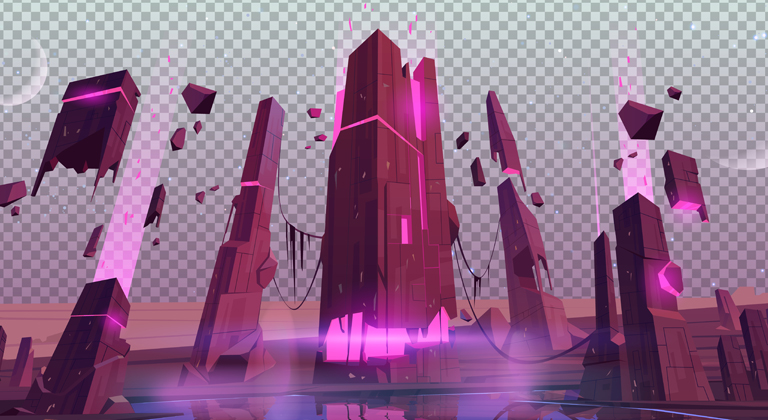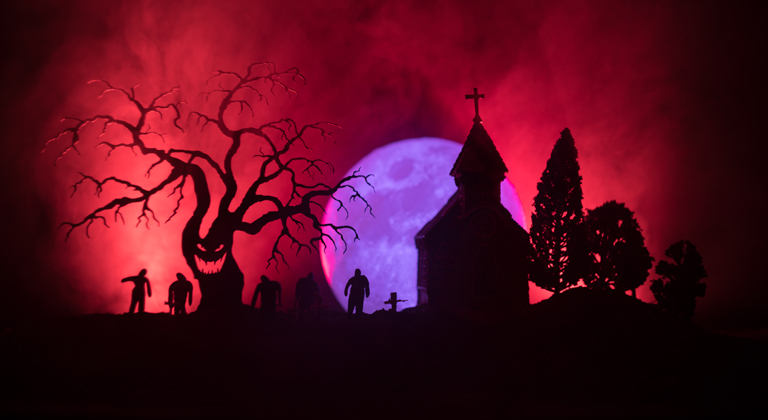Mastering the Craft of World-Building in Science Fiction
One thing that separates genres like science fiction from others, is the idea that they usually take place in an unfamiliar setting. Whether it’s a completely alien world, the distant future, or simply a slightly different version of earth than our own, it is this unfamiliarity that allows a reader’s imagination to really soar. But world-building isn’t easy.
For many authors, building a whole new world or reality can be intimidating, but it’s still the most important skill to master if you want to write engaging, provocative science fiction. Fortunately, many successful sci-fi authors have already paved the way, perfecting techniques at world-building to write truly groundbreaking and award winning novels. By studying what they’ve done, you can put together believable worlds of your own, which is why Ginger has broken down those techniques into a list of tips and strategies that are common to most science fiction novels.
World-building is intimidating – but it’s also the most important skill to master if you want to write engaging, provocative science fiction.
Since the genre was created (something generally credited to Mary Shelley, for her 1818 novel Frankenstein) science fiction has always been a category of fiction that invites readers to explore uncharted territories, venture into the unknown, and contemplate the limitless possibilities of the universe.
At the heart of the best science fiction stories has always been the skillful art of world-building – a process through which authors construct intricate and immersive fictional worlds for their characters (and readers) to explore.
But how can science fiction writers effectively build these “strange new worlds”? Here are some tips and suggestions I’ve gleaned from reading the works of the most masterful science fiction writers both past and present, including some examples to illustrate the effectiveness of these strategies. Hopefully, the wisdom of the great sci-fi writers of our time can help you build more compelling and believable worlds within your own novels.
1. Start with a Strong Concept
World-building requires you to build a sandbox for your characters to play in – but it has to be starkly different from our own. Effective world-building in science fiction usually begins by identifying a central concept to skew – something different about this new world that serves as the foundation for making your entire universe feel alien. This concept could be a technological innovation, a story set in an alternate reality, or a tale about something weird and unique happening to your central characters. Whatever you decide on, a strong concept will not only engage your readers more effectively, but also shape the rules, culture, and social dynamics within the world you’re building.
Example: Philip K. Dick’s Do Androids Dream of Electric Sheep?
In 1968, author Phillip K. Dick welcomed us to a dystopian San Francisco ravaged by nuclear war, in which android servants live and serve among the surviving humans. This concept of humanoid androids and how they blur the lines between what defines “man” and “machine” forms the bedrock of the narrative, influencing not only the plot but also the societal norms and ethical considerations within the world Dick has created. Much like for viewers of Blade Runner, the movie inspired by Dick’s novel, readers are ultimately left asking themselves the difficult question of what it truly means to be human; and what it means to be inhuman.
2. Consistency in Rules and Laws
A well-built science fiction world adheres to a set of internal rules and laws that govern its functioning – and a good author never strays from them! These rules could relate to physics, technology, biology, or even the laws and system of magic as it exists in more fantastical science fiction. Whatever the “rules” of your fictional world are, consistency and commitment to these is key. Readers should be able to rely on the established rules because they provide context to each character’s motivations, and help make sense of things as the reader navigates your other-earthly world.
Example: Isaac Asimov’s Foundation Series
Alongside Robert A. Heinlein, Arthur C. Clarke, and Ursula K. Le Guin, Isaac Asimov is considered one of the foundational authors of the science fiction universe – and appropriately enough, he’s perhaps best known for a science fiction book series called Foundation.
The Foundation universe revolves around the concept of “psychohistory” – a science that combines psychology, history, and mathematics to predict large-scale societal trends. This concept sets the stage for the intricate plots and political maneuverings that make each book and short story in the series such page-turners. By maintaining the consistency of psychohistory’s influence, Asimov crafts a world that feels coherent and believable; and makes us understand why characters make the decisions that they do.
3. Cultural Diversity and Societal Structures
As fans of Star Trek will attest to, the best science fiction features richly developed worlds that include diverse cultures, societies, and hierarchies. These elements add depth to the universe, help foster a sense of “otherness” for the reader, and provide opportunities to explore themes such as identity, power dynamics, and social issues free from the contentious constraints of political discussion in the real world.
Example: Ursula K. Le Guin’s The Left Hand of Darkness
In 1969, Ursula K. Le Guin thrust herself into prominence with the publication of The Left Hand of Darkness – the fourth book in her Hainish Cycle series, and the one that truly established Le Guin as a culturally significant science fiction writer.
Set in the fictional world of Gethen, Le Guin writes about a world inhabited by androgynous beings who only adopt gender during specific phases. True to the conventions of all the best science fiction, this concept challenges our conventional notions of gender identity and highlights the influence societal norms have on individuals.
By exploring various cultural perspectives within this framework, Le Guin crafts a world that is utterly believable, but also both alien and deeply relatable.
4. Detailed Geography and Setting
Just as the “rules” of your fictional world have to be consistent, so does the geography. Descriptive geography and an immersive setting contribute to the overall realism of your science fiction world and help readers feel like they’re really there. This can be achieved with evocative descriptions of landscapes, cities, and environments – using smells, sensations, and sounds to immerse readers in your universe and make them feel like they’re right alongside your characters.
Example: Frank Herbert’s Dune
Frank Herbert’s 1965 epic Dune is considered one of the greatest science fiction novels of all time, and key to its timeless success is Herbert’s inspired world-building.
The intricate desert world of Arrakis that Herbert created is brought to life for readers through his vivid descriptions. Whether he’s writing about the arid landscapes, terrifying encounters with sandworms, or the challenges of surviving in the spice-rich environment, Herbert creates a “sense of place” that is central to the story’s narrative, and provides vital context to the cultural dynamics of the people who live there. The harsh yet mesmerizing landscape of Arrakis becomes an integral part of the story – a character even more important than Paul Atreides himself. Dune simply wouldn’t exist without… Dune; and the worlds you create should be no less impactful.
5. Incorporate Historical and Societal Contexts
History provides context for why the towns and cities we live in are the way they are, and that’s no different when you’re creating fictional worlds. Embedding historical and societal details within the science fiction world you’re writing about helps lend authenticity and depth. Additionally, these fictional contexts can be written to mirror real-world issues, allowing authors to draw parallels with real problems and craft a political narrative that’s insulated by the protective buffer of “it’s only fiction.”
Example: Octavia Butler’s Kindred
Hugo and Nebula award-winning author Octavia E. Butler was the first science fiction author to receive a MacArthur Fellowship, and a pioneer for authors of color. In her 1979 novel Kindred, Butler blends science fiction with historical fiction, transporting a modern African-American woman back in time to the antebellum South. By juxtaposing the protagonist’s modern-day experiences with the historical horrors of slavery, Butler is able to explore the impact of culturally uncomfortable history on the present – and remark on the enduring problems caused by those centuries of systemic oppression.
6. Characters as Vessels of Exploration
While world-building is a vital part of good science fiction writing, one of the common pitfalls for aspiring authors is to build worlds at the expense of building characters. That’s why a good technique employed by the best science fiction writers is to use well-developed characters as the vehicles through which readers can explore the intricacies of the science fiction world you’re trying to create. By giving them compelling motivation based on the context of your fictional world, you can leverage their perspectives, emotions, and interactions to paint a more believable picture of your fantastical environment.
Example: Orson Scott Card’s Ender’s Game
The Nebula and Hugo award-winning book Ender’s Game introduces readers to a futuristic Earth threatened by an alien species known as the Formics. In the novel, author Orson Scott Card explores the complexities of interstellar warfare, child prodigies, and moral dilemmas through the experiences of his protagonist, young Ender Wiggin. Ender’s adventures provide a lens through which readers uncover the world’s political tensions, understand its technological advancements, and ponder the ethical conundrums posed by a planet trapped in a state of eternal conflict.
Conclusion
Whether it’s writing about encountering something unearthly in our own world, or crafting an entire fictional universe, world-building is one of the cornerstones of good science fiction. It’s not easy embarking on such a labor of imagination – but writers who master world-building gain access to a tool that can elevate their stories from simple tales to immersive journeys.
But while it might not be easy, world-building is straightforward. Begin with a strong concept for your fictional world. Then, establish the world’s consistent rules that each of your characters must live by. Next, paint a picture of the cultural diversity, detailed geography, and historical context that infuses your world. Finally, utilize your characters as vessels to explore this strange new world.
Authors who are successful in crafting such worlds can engage readers’ minds and emotions at a deep and fundamental level. As demonstrated by the examples I shared from Philip K. Dick, Isaac Asimov, Ursula K. Le Guin, Frank Herbert, Octavia Butler, and Orson Scott Card, effective world-building can be a gift that allows readers to traverse impossible galaxies, contemplate unfathomable possibilities, and glimpse into the infinite horizon of the human imagination.












4 Comments